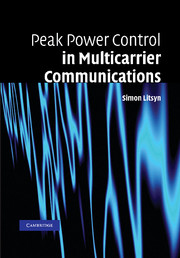Book contents
- Frontmatter
- Contents
- List of figures
- List of abbreviations
- List of notation
- 1 Introduction
- 2 Multicarrier signals
- 3 Basic tools and algorithms
- 4 Discrete and continuous maxima in MC signals
- 5 Statistical distribution of peak power in MC signals
- 6 Coded MC signals
- 7 MC signals with constant PMEPR
- 8 Methods to decrease peak power in MC systems
- Bibliography
- Index
8 - Methods to decrease peak power in MC systems
Published online by Cambridge University Press: 03 December 2009
- Frontmatter
- Contents
- List of figures
- List of abbreviations
- List of notation
- 1 Introduction
- 2 Multicarrier signals
- 3 Basic tools and algorithms
- 4 Discrete and continuous maxima in MC signals
- 5 Statistical distribution of peak power in MC signals
- 6 Coded MC signals
- 7 MC signals with constant PMEPR
- 8 Methods to decrease peak power in MC systems
- Bibliography
- Index
Summary
In this chapter, I consider methods of decreasing peak power in MC signals. The simplest method is to clip the MC signal deliberately before amplification. This method is very simple to implement and provides essential PMEPR reduction. However, it suffers some performance degradation, as estimated in Section 8.1. In selective mapping (SLM), discussed in Section 8.2, one favorable signal is selected from a set of different signals that all represent the same information. One possibility for SLM is to choose the best signal from those obtained by inverting any of the coordinates of the coefficient vector. The method of deciding which of the coordinates should be inverted is described in Section 8.3. Further, in Section 8.4 a modification of SLM is analyzed. There the favorable vector is chosen from a coset of a code of given strength. Trellis shaping, where the relevant modification is chosen based on a search on a trellis, is described in Section 8.5. In Section 8.6, the method of tone injection is discussed. Here, instead of using a constellation point its appropriately shifted version can be used. In active constellation extension (ACE), described in Section 8.7, some of the outer constellation points can be extended, yielding PMEPR reduction. In Section 8.8, a method of finding a constellation in the frequency domain is described, such that the resulting region in the time domain has a low PMEPR. In partial transmit sequences (PTS), the transmitted signal is made to have a low PMEPR by partitioning the information-bearing vector to sub-blocks followed by multiplying by a rotating factor the coefficients belonging to the same sub-block.
- Type
- Chapter
- Information
- Peak Power Control in Multicarrier Communications , pp. 209 - 252Publisher: Cambridge University PressPrint publication year: 2007



